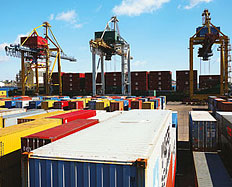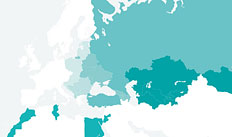Chapter 4
Regional integration and economic institutions
Leveraging regional economic integration to improve institutions is difficult. International evidence suggests that there is no clear trend in terms of institutional change in regional trade blocs. For example, if the quality of institutions is measured by the average of the six World Bank Governance Indicators (voice and accountability, political stability and absence of violence, government effectiveness, regulatory quality, rule of law and control of corruption), it has been declining, on average, in Mercosur countries and has exhibited no clear course in the Caribbean Community (CARICOM). This can be illustrated with reference to the specific indicator for regulatory quality (see Chart 4.10).
Source: World Bank, Kaufmann et al. (2009) and authors’ calculations.
Note: Higher values correspond to better institutions. Mercosur excludes Venezuela, ASEAN excludes Myanmar. OECS is Organisation of Eastern Caribbean States. EU Enlargement includes countries that acceded in 2004, Bulgaria, Romania and Croatia.
The European Union appears to be the main exception in this respect. The average quality of EU institutions has been improving, driven mainly by the convergence of the new member states towards the level of the more advanced countries. This could be attributable to the deeper institutional integration and the special role of supranational governance structures within the Union.
At the same time, deeper regional economic integration has typically led to some degree of convergence of institutional quality in member countries. This has occurred across a range of institutions and has been most apparent in terms of regulatory quality (see Chart 4.11). In particular, the standard deviation of the regulatory quality indicator (a measure of its dispersion across countries) has, on average, declined over time. Convergence has been most pronounced in the new, post-2004 EU member states (and similarly in parts of the Caribbean region – see Box 4.5). Some convergence was also discernible in other regional integration entities in the 1996-2010 period, although institutions tended to converge to the average, rather than best practice, level within their integration bloc. In contrast, there has been no clear convergence trend in the CIS over the last decade.
Source: World Bank, Kaufmann et al. (2009) and authors’ calculations.
Note: Mercosur excludes Venezuela, ASEAN excludes Myanmar. OECS is Organisation of Eastern Caribbean States. EU Enlargement includes countries that acceded in 2004, Bulgaria, Romania and Croatia.
The scope for convergence is more limited within the Eurasian Economic Community, where there is little variation in institutional quality and no country has strong enough institutions to serve as a natural model to follow (see Chart 4.12). The challenge is therefore to leverage deeper integration with supranational governance structures in order to build collective institutions which are stronger than those in any individual member country. One opportunity to do so is to ensure good governance in newly established supranational-level structures.
Source: World Bank, Kaufmann et al. (2009) and authors’ calculations.
Note: Average of the six World Bank Governance Indicators (voice and accountability, political stability and absence of violence, government effectiveness, regulatory quality, rule of law and control of corruption). Higher values correspond to better institutions. Mercosur excludes Venezuela, ASEAN excludes Myanmar. EU Enlargement includes countries that acceded in 2004, Bulgaria, Romania and Croatia. EU-28 includes all current EU members and Croatia.
Another mechanism that can help to improve institutions is a degree of competition between different jurisdictions. Within the Common Economic Space, for example, firms may choose to operate across borders and locate themselves in those environments that offer a better business climate and a lower regulatory burden. The World Bank Doing Business league suggests that there may be scope for such jurisdictional arbitrage, with Kazakhstan ranked 47th out of 183 countries (but 176th in the subcategory of trading across borders), Belarus 69th and Russia 120th. Within Russia, in turn, there are large regional variations in business environment quality.36 This creates incentives for countries to improve various components of the business climate by adopting best practices from other bloc members and also from well-performing regions within countries.
Deeper integration may also prompt member countries to improve their macroeconomic policies. For example, in response to its 2011 balance-of-payments crisis, Belarus temporarily imposed price controls and multiple exchange rates, but this policy proved hard to sustain given the open border arrangement with Kazakhstan and Russia. At the same time, however, Belarus’s recovery has been supported through a conditional Eurasian Development Bank assistance programme.
36 See World Bank (2012) and EBRD (2012).







